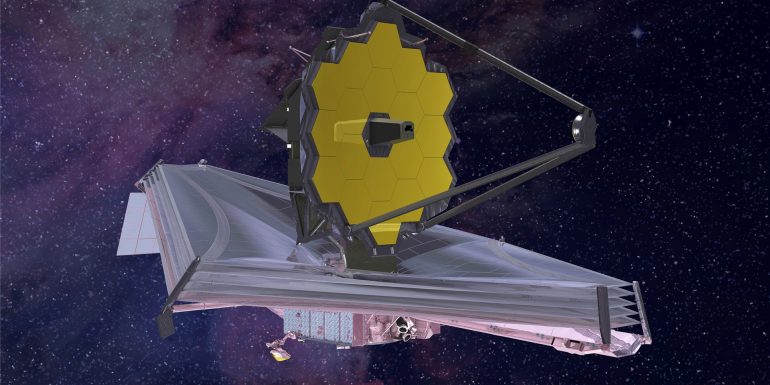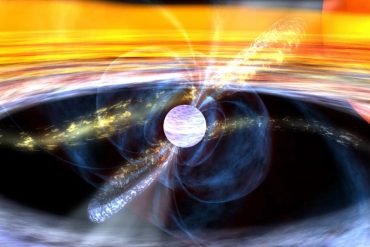A look into the past billions of years and the prospect of a second Earth exploration for future generations: all of this should soon be possible with a space telescope.
Scientists hope to look back to the early days of space after the Big Bang, 13.8 billion years ago. On images of stars that are older than our solar system and may no longer exist.
Possibly also evidence of a second Earth, a blue planet. With the launch of the James Webb Space Telescope (JWST) planned for autumn, researchers expect an entirely new insight.
“It will simply open up huge new windows and new possibilities,” says Günther Hasinger, director of science at the European Space Agency Esa.
“James Webb” works 1.5 million km away
The start of the nearly ten billion dollar project of the US and Canadian space agencies NASA and Essa was repeatedly postponed.
Now the giant telescope, as it was packaged as a package, is due to take off on board the Ariane launcher in the autumn and go far deeper into space with its four infrared instruments than its predecessor, the “Hubble” Space Telescope. To fly, which has been in operation for more than 30 years.
But this is a risk: while “Hubble” was repaired and serviced several times with shuttle flights at an altitude of 500 kilometers, this is no longer possible with the “James Webb Space Telescope” at 1.5 million kilometers .
According to Hasinger, a telescope with a 6.5-meter mirror and a sunshade the size of a tennis court required more than 130 individual mechanisms to reveal the telescope. “It’s a very complicated game to play until everything is revealed.” He likens it to a butterfly: “The caterpillar pupates, and then the pupa breaks up and the butterfly opens.”
First photos expected from July 2022
This process begins on the way to the goal. “There are five points in the solar system where gravity cancels each other out,” Hasinger says. Destination is one of them. There, with the Earth and Sun behind them and an awning protected from heat radiation, the instruments can begin their measurement in various infrared waves.
For this they are partially cooled. “This will be the first cold telescope. If you want to measure infrared rays, which is heat radiation, the telescope itself has to be very cold,” Hasinger says.
The first exam will take about seven months. Hasinger believes the first photos will be available in July. According to the institute, an instrument co-developed by the Max Planck Institute for Astronomy in Heidelberg, the combination of camera and spectrograph is sensitive enough that it can detect a burning candle on the Jupiter moon.
“Dense molecular clouds with lots of dust and gas are where new stars and planets form. However, dust absorbs the visible light that we are familiar with by sight, and therefore it is difficult or impossible for us to study their interior regions in detail, ”says Claus Jger of the Max Planck Institute.
Dust is a very small barrier to long wave infrared light. “Observations in the infrared therefore allow us to see these regions or to receive infrared radiation from within.”
According to Hasinger, an in-depth survey of the early expanding universe and exploration of star formation regions are planned with the telescope. “But then a substantial portion of the observation time will go to the extrasolar planets.”
The telescope can probe the environments of such exoplanets for molecules that may indicate biological activity. “Whether it succeeds or not depends on whether we find the right planets.”
Evidence of Earth-like Planets
The strength of the telescope lies in its spectroscopy – that is, you can take a chemical fingerprint from any point in the sky. “A picture is beautiful to look at. What we get with “James Webb” is that we can read up to 1000 other pieces of information in each picture element,” Hasinger says.
For example, is it possible to have water anywhere. The near-Earth planets are certainly interesting. “At some point you want to find a planet that is as Earth-like as possible and where water is present and that is close enough that future generations will be able to fly there.”
So possibly an Earth 2 can be found. The telescope “will likely be able to detect whether there is oxygen or ozone or other potential biomolecules”. This is possible at distances of up to 1000 light years. With respect to dimensions: A light year describes the distance that light travels in a year – about 9.5 trillion kilometers. From the Sun, which is about 150 million kilometers away, it takes about eight minutes for light to reach Earth.
Telescope gives a glimpse into the past
NASA science director Thomas Zurbuchen said in early June that the first galaxies formed after the Big Bang should be seen with a telescope. Accordingly, it should offer a glimpse of the past 13.5 billion years ago – much further than its predecessor “Hubble”.
“It would show us something so new that we would flap our ears,” Hasinger says. “James Webb” works in the infrared, “Hubble” in the optical and ultraviolet ranges. It would be ideal if Hubble continued to operate for as long as possible. “Because then you’ll get a full ribbon of rainbows.”
Hasinger expects the telescope to be named after former NASA boss James Edwin Webb to ten years old. Then he would have run out of fuel, so to speak. For the project, which has been developed for about 25 years, NASA initially expected to cost about $500 million. “Scientists and engineers of the time made a horribly wrong estimate,” says Hasinger.
However, for Hasinger the benefits of the $10 billion project are clear. “Such people are curious and always try to understand everything in their environment.” The question is where do we come from and where are we going. “The question is, how did the universe originate and how will it continue to evolve? The galaxy, the solar system, how did life come into existence?”
Jagger says: “In my opinion, one thing is already certain and an experience from many other milestone projects: with “JWST” we will make discoveries that we have not yet suspected!”
DPA
urn:newsml:dpa.com:20090101:210816-99-856327/3

Internet fan. Alcohol expert. Beer ninja. Organizer. Certified tv specialist. Explorer. Social media nerd.





